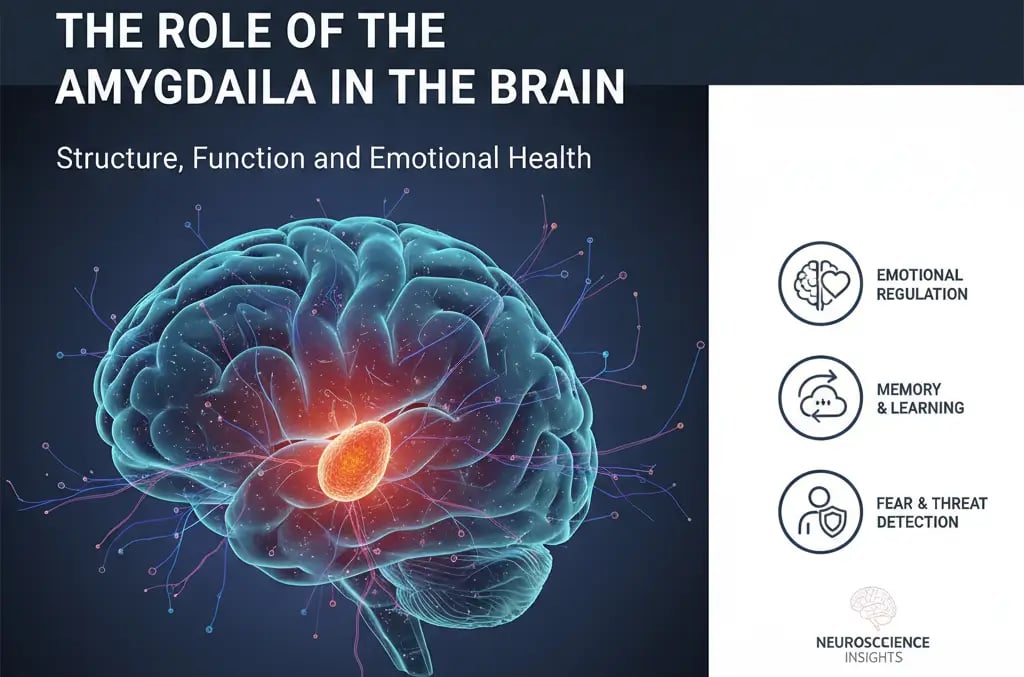The Role of the Amygdala in the Brain: Functions, Structure, and Emotional Health
Discover the vital role of the amygdala in emotional processing, memory, and stress response. Learn how this small brain structure influences behavior and mental well-being.


🧠 The Role of the Amygdala in the Brain: Structure, Function, and Emotional Health
The amygdala is a small but powerful structure located deep within the brain’s limbic system. This almond-shaped cluster of nuclei plays a vital role in emotional processing, fear response, memory formation, and stress management. By evaluating and responding to environmental stimuli, the amygdala helps determine how we react to different situations — shaping our behavior, decisions, and emotional health.
🔍 What Is the Amygdala?
The amygdala is a pair of small, almond-shaped structures found deep inside the temporal lobes of the brain. It is closely linked with the hippocampus, which helps store and retrieve memories. Together, these regions work to connect emotions with past experiences, enabling us to learn from our environment and adapt accordingly.
⚡ The Amygdala and the Fight-or-Flight Response
One of the most well-known functions of the amygdala is its role in triggering the fight-or-flight response. When the brain detects a potential threat, the amygdala rapidly processes sensory information and activates the autonomic nervous system. This triggers physiological reactions such as increased heart rate, rapid breathing, and a surge of adrenaline — preparing the body to either confront danger or escape it.
This immediate, instinctive response underscores how crucial the amygdala is in managing stress and ensuring survival.
💭 The Amygdala’s Role in Emotional Learning and Memory
The amygdala also plays a major part in emotional learning and memory consolidation. It assigns emotional significance to experiences, allowing the brain to remember events that have strong emotional impact — such as fear, happiness, or sadness.
This connection between the amygdala and hippocampus strengthens memory formation and helps individuals learn from emotionally charged experiences. For instance, a frightening situation is more likely to be remembered vividly, serving as a protective mechanism against future dangers.
😊 The Amygdala and Social Behavior
Another fascinating aspect of amygdala function is its role in interpreting facial expressions and social cues. By reading emotional signals from others, the amygdala helps us respond appropriately in social situations. This ability enhances empathy, communication, and relationship building — all of which are essential for healthy social interactions.
🧩 Structure and Location of the Amygdala
Anatomically, the amygdala is a complex cluster made up of several nuclei, each with specialized roles:
Basolateral complex: Interacts with the prefrontal cortex, which controls decision-making and higher-order thinking.
Central nucleus: Connects to the brainstem and hypothalamus, influencing physiological and behavioral responses to emotions.
The amygdala’s close proximity to the hippocampus allows seamless communication, enhancing the processing and storage of emotional memories. Its position within the limbic system places it at the center of emotional regulation and cognitive control.
🧘♀️ How to Keep Your Amygdala Healthy
A healthy amygdala is essential for emotional stability, stress regulation, and mental well-being. Here are proven ways to support amygdala health and brain function:
1. Manage Stress Effectively
Chronic stress can overactivate the amygdala, leading to anxiety and emotional imbalance. Techniques like mindfulness meditation, deep breathing, and cognitive-behavioral therapy (CBT) help calm the nervous system and reduce stress hormones.
2. Get Adequate Sleep
Quality sleep is critical for amygdala function. Lack of rest can heighten emotional reactivity and impair decision-making. Aim for 7–9 hours of restful sleep each night to support brain repair and emotional balance.
3. Eat a Brain-Boosting Diet
A balanced diet rich in omega-3 fatty acids, antioxidants, and vitamins nourishes the brain. Include foods like:
Fatty fish (salmon, tuna)
Nuts and seeds
Leafy green vegetables
Dark chocolate
These nutrients help protect neurons and reduce oxidative stress.
4. Exercise Regularly
Physical activity increases blood flow to the brain and releases endorphins, which naturally reduce stress and boost mood. Aerobic exercises like walking, swimming, or cycling are particularly beneficial.
5. Cultivate a Positive Lifestyle
Avoid harmful substances like alcohol and drugs, as they can damage brain cells and affect emotional stability. Engage in social connections, goal-setting, and enjoyable hobbies to maintain a positive mindset and enhance amygdala resilience.
🧠 Final Thoughts
The amygdala plays a pivotal role in emotional regulation, stress response, social understanding, and memory formation. Its ability to process emotions and connect them with memories makes it one of the most important structures in the brain.
By managing stress, getting proper sleep, eating a nutrient-rich diet, exercising regularly, and maintaining positive relationships, you can support your amygdala health and improve your overall emotional and mental well-being.
